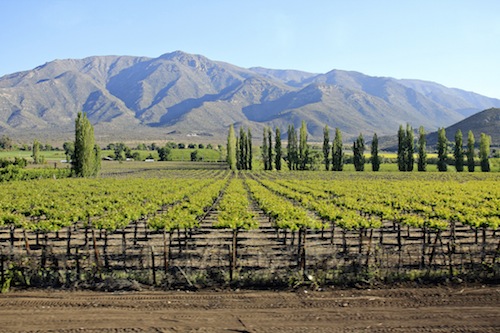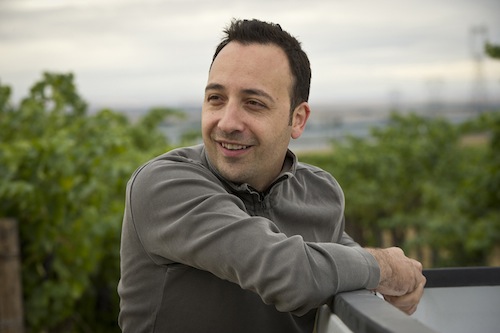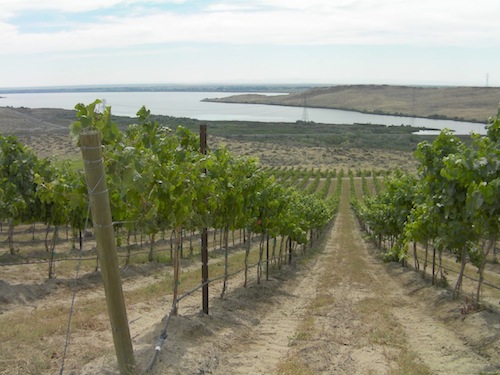
KENNEWICK, Wash. — Is Argentina the king of Malbec? On a global level, the answer is an undisputed “yes.” But a blind tasting conducted by Great Northwest Wine indicates Washington state is catching up quickly and becoming an important part of the conversation.
Wine grapes have been grown in Argentina for nearly five centuries, and Malbec has become the South America country’s darling because of hard work, determination and brilliant winemaking.
Juan Muñoz-Oca, head winemaker at Columbia Crest in Paterson, Wash., grew up in Mendoza — the heart of Argentina’s Malbec industry — and he worked at wineries there before emigrating to Washington state in 2003 to work for Ste. Michelle Wine Estates.
In the past decade, interest in Malbec has risen considerably in Washington, and one winery – Hamilton Cellars in Richland – focuses almost all of its efforts on producing Malbec.
Argentina’s history, location an advantage

While Washington is coming on quickly as a source of superb high-end Malbecs, Argentina’s breadth of knowledge and depth of viticulture give the Mendoza region a big edge, Muñoz-Oca said.
“I feel the Malbecs grown in Argentina have two big advantages over any other Malbec,” Muñoz-Oca told Great Northwest Wine. “Years and years of field selections from the best-performing vines have been passed from generation to generation, from grandparents to kids. That selection is unique. They are working with material that looks different from the rest of the Malbec grown around the world.”
Additionally, Muñoz-Oca noted, is the growing season. Because the vineyard are at high altitudes – 2,900 to 4,700 feet above sea level – the UV exposure in the vineyard is different.
“They have a really long growing season,” Muñoz-Oca said. “Washington has a long season, but it gets really hot really quickly in the summer (in Washington).”
As a result, the flavor development in Washington lags behind the sugar accumulation through most of the growing season.
“They all meet at the end of September and early October,” he said. “In Argentina, they go hand in hand. I think the Argentine Malbecs have higher flavor development with lower sugars. That gives them a balance that’s hard to reach anywhere else.”
Where does Washington Malbec stack up?

So we decided to put this premise to the test. We wanted to see where Washington stands with the world’s best.
Muñoz-Oca was tasked with finding four examples of high-end Argentine Malbecs. These would not be the low-priced examples often found at U.S. grocery stores. Rather, these are Malbecs in the $30-$50 range that are rarely exported – and then only to discerning wine merchants.
Muñoz-Oca took his assignment seriously. Even though he grew up in Mendoza and worked in the Argentine wine industry prior to moving to Washington, he decided to call several friends down in Argentina and get their advice. He looked for examples from different areas of Mendoza and varying elevations to reveal the region’s full range of complexity.
While he researched top Mendoza Malbecs, we chose four examples of great Washington Malbecs. Fortunately, we taste a lot of Malbec, so the choices narrowed quickly. Two came from the Horse Heaven Hills – from vineyards that are perhaps five miles apart. We also picked one from Snipes Mountain, an appellation in the middle of the Yakima Valley. The final wine was Muñoz-Oca’s reserve Malbec from Columbia Crest, and wine that is not yet released.
Once the eight wines were selected, we put them to the test of a blind tasting; none of our five judges knew which wine was which. Hank Sauer, master facilitator for Great Northwest Wine, ensured the integrity of the judging. All of the wines were decanted prior to the tasting to ensure they all showed their best.
Our five judges were:
- Juan Muñoz-Oca, head winemaker for Columbia Crest and former Mendoza winemaker.
- Jessica Munnell, head winemaker at Mercer Estates in the Yakima Valley town of Prosser. She and Muñoz-Oca are married.
- Coke Roth, longtime international wine judge who has tasted with Great Northwest Wine for the better part of two decades.
- Eric Degerman, longtime wine writer, international wine judge and co-owner of Great Northwest Wine.
- Andy Perdue, wine judge, author and Seattle Times columnist, who co-owns Great Northwest Wine with Degerman.
After the judging occurred and the votes were tallied but before the wines were revealed, Muñoz-Oca expressed surprise at how even the wines showed. He was excited at just how well the best of Washington performed against top Argentine Malbecs.
And when he learned the results, he was stunned – and pleased with the wines of his adopted home.
Argentina-Washington Malbec smackdown results
1. (tie): Hamilton Cellars 2010 Champoux Vineyard Malbec, Horse Heaven Hills, $45: The grapes for this wine were the first crop of Malbec ever harvested at famed Champoux. In the hands of master winemaker Charlie Hoppes, they showed this site’s stunning potential for Malbec. It shows off aromas of white pepper, blueberry, dried flowers and dark chocolate. The flavors are dark and brooding with deep, rich notes of Marionberry, smoky pepper and anise. It rides the line of being extracted yet still elegant.
1. (tie): Mercer Estates 2010 Spice Cabinet Vineyard Malbec, Horse Heaven Hills, $30: This didn’t surprise us, as every single Malbec off this young vineyard overlooking the Columbia River has been stupendous. It offers aromas of cedar, blackberry, chorizo sausage and cherries dipped in dark chocolate. On the palate, we loved the silky tannins that back the rich, ample dark fruit. Everything is in harmony with the superb wine. Only 127 cases were made, and it will be released to wine club members Oct. 27. It should be noted that Jessica Munnell, Mercer’s winemaker, was one of our five judges. She did not recognize the wine. In fact, of the five judges, her score was fourth-highest.
3. Columbia Crest 2011 Reserve Malbec, Columbia Valley, $30: This was bottled just a couple of weeks before the blind tasting, and this already was showing beautifully. Muñoz-Oca brought in fruit primarily from Rob Andrews’ vineyard in the Horse Heaven Hills, as well as a bit from Jones Vineyard on the Wahluke Slope and Spice Cabinet Vineyard in the Horse Heavens. It is an elegant wine with aromas of lavender, lilac, Tahitian vanilla, purple plum and Marionberry. On the palate, it offers stunning flavors of blackberry, black licorice, graphite, dark chocolate and pipe tobacco. It’s all backed with fine-grained tannins that perfectly balance the voluptuous flavors.
4. Fabre Montmayou 2008 Grand Vin, Lujan de Cuyo, $39: Owner Hervé Joyaux Fabre is a Bordeaux native who arrived in Argentina in the early 1990s in search of the world’s finest Malbec. The estate vines for this wine were planted in 1908, and each grape was hand-selected prior to crush. The resulting wine was aged in French oak for 16 months. It is a blend of Malbec (85%), Cabernet Sauvignon (10%) and Merlot. It was the highest-ranked Argentine wine for this judging and shows off aromas of black licorice, black olive, minerality, vanilla extract and Marionberry. On the palate, it is a big, broad-shouldered red with bold tannins backed with equally impressive and expressive fruit. Black currant and blackberry cobbler highlight this sophisticated red wine.
5. Upland Estates 2009 Malbec, Snipes Mountain, $30: Grape grower Todd Newhouse and winemaker Robert Smasne team up to produce what is consistently one of the finest Malbecs in Washington. Past vintages have won award after award at top judgings, and this version shows tremendous promise. It opens with aromas of lilac, lavender, blackberry and roasted meat. Bold flavors are backed by sleek, elegant tannins that allow the dark fruit to envelop the palate. This shows off flavors of Tahitian vanilla, plum jam, dried flowers, black olive and black pepper. A stunning wine with breadth and depth.
6. Trapiche 2008 Viña Cristina y Bibiana Coletto, Mendoza, $50: Trapiche is one of Argentina’s most famous wineries. It was founded in 1883 and is hailed as one of the country’s finest producers. The average age of the vines in this single-vineyard bottling was 54 years. Daniel Pi is the winemaker and is one of Argentina’s most-respected winemakers. Muñoz-Oca describes Trapiche as “the Columbia Crest of Mendoza. You can buy a good bottle of Trapiche Malbec for $8, or you can spend $50 for a really high-end Malbec.” This opens with smoky aromas of charcoal and sizzling ham, followed by hints of Marionberry and black pepper. On the palate, this screams “Argentina!” with its wet stone notes and is balanced with flavors of black olive, black fruit and hints of violet. It’s all backed with big tannins and ample acidity.
7: Lindaflor 2005 Valle de Uco, Mendoza, $50: Bodega Monteviejo is the French-owned producer of this famed Argentine Malbec from Vista Flores, south of Mendoza. High-flying Bordeaux wine consultant Michel Roland works with winemaker Marcelo Pelleriti to craft the wines of Monteviejo. This is 100 percent Malbec and is aged 18 months in 100 percent new oak. It is an elegant red that opens with aromas of blackberry sauce and vanilla, followed by rustic flavors of dark chocolate, plum and boysenberry. Rich tannins back bold fruit in this big wine.
8. Catena Alta 2009 Estate Rows Malbec, Mendoza, $60: Nicola Catena emigrated from Italy to Argentina in 1898 and began planting Malbec in 1902. Today, Nicolas Catena and his daughter Laura run the family operation, and Alejandro Vigil crafts the wines. The grapes for this wine came from vineyards that range in elevation from 3,018 feet to 4,757 above sea level, then is aged in 50 percent new oak. Sweet oak, cocoa powder and blackberry notes greet the nose, followed by flavors of saddle leather, moist earth, violet and black truffle. It’s an intriguing wine that was quite distinct from the other seven Malbecs tasted.
Our original goal was to create a baseline for where Washington Malbecs stand among some of the best in the world. We certainly did not expect them to earn four of the top five spots against such superb Argentine wines.
While all of the wines were tasted blind and by judges with international palates, we hope to reconstruct this tasting next year in Mendoza with Argentine Malbec experts and see how the results might differ.

Malbec has been grown in Argentina for five centuries? Any chance of citing the source for this information? My understanding (and I have been making malbec in Mendoza for the past fifteen years and during that time have had a chance to get to know the scene rather well) is that malbec was introduced in the latter half of the 19th century by French agronomists.
Hi, Patrick. Wine grapes in general have been grown in Argentina since the the 1550s, as the article states. Malbec is a more recent development. One of the wines we tasted comes from vines more than a century old.
Andy,
Interesting article and I have no doubts as to its “Authenticity” but because I read a fair amount of articles about vineyards and the wine industry I feel any “Blind” tasting should be only be after the Judges involved have passed a simple test. The test is where five wines are tasted in the Blind of which three wines are the same. This format has derailed most “Wine Critics” because they cannot even identify the same wine, rather they rate it differently even though it came from the same bottle.
I have also read about Wine Critics choosing a “Box Wine” over expensive French wine.
All I am saying is Blind wine tasting tests can be skewed.
I own a 108-acre vineyard development in San Rafael, Argentina and I welcome quality wine from wherever it may be. Maybe some day that will be the Moon or Mars. Who knows.
Tom,
Thanks for the note. You make excellent points. We’ve done the test you mention on multiple occasions. It’s a good one that can trick even the most seasoned wine critic or winemaker.
All of the people who participated in this particular blind judging have each tasted tens of thousands of wines through their careers.
We would love to somehow replicate this tasting in Mendoza. Perhaps you’d be interested in participating if we can pull it together?
Andy, I respect you and Eric immensely – you know that. I haven’t met Coke, although we share certain relationships in common, he lends a certain air of respectability to this tasting. I haven’t had the pleasure of meeting Juan and Jessica yet in my travels.
V&I host a “Double Blind Red” in the Fall with friends of ours usually 10 to 14 of them. Not too far back we held a double blind Malbec tasting where I bag ’em and V tags ’em. We then have our guests rate them on score cards. Not too scientific but it is interesting to see and hear what our consumer contemporaries say regarding the entrants. We had 6 Malbecs; 3 WA and 3 Argentinian. The Argentinian ones came in 1, 2, and 3 whilst the WAs came in 4, 5, and 6. With #6 the most expensive. I was stunned as I am reading the outcome of your tasting. Maybe you, Eric, and Coke could get together with V&I and give us a “lesson.” We are always up for educational experiences from Masters. Best Regards,
B&V
Benn,
Thank you for the comment. I’d be interested in knowing (via email) what the six wines you tasted were.
To be honest, we expected the Argentine wines to come out ahead, and we were using this tasting as a scorecard – a benchmark, perhaps – for where Washington stands. We most certainly did not expect Washington to compete so well.
It’s also interesting to note that the most expensive wine in this tasting also finished at the bottom. Not sure what it means, but it’s interesting.
Great article and what a interesting outcome, I am truly excited for the potential of Malbec in Washington state, it’s an amazingly diverse wine and can only help the future of the wine industry. Bring it Argentina.
I can;t help but think your ideas on wine would be improved by travel outside of Benton County.
Florence, thanks for the feedback, though we don’t quite understand your point.
Great to see Bertie Wooster’s ex-fiancee is paying attention to our wine country coverage.